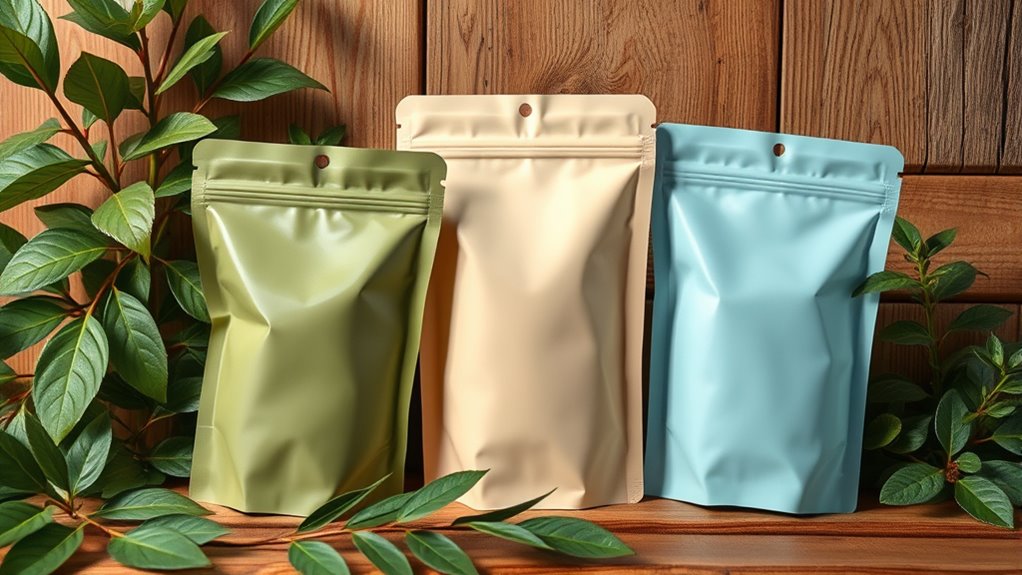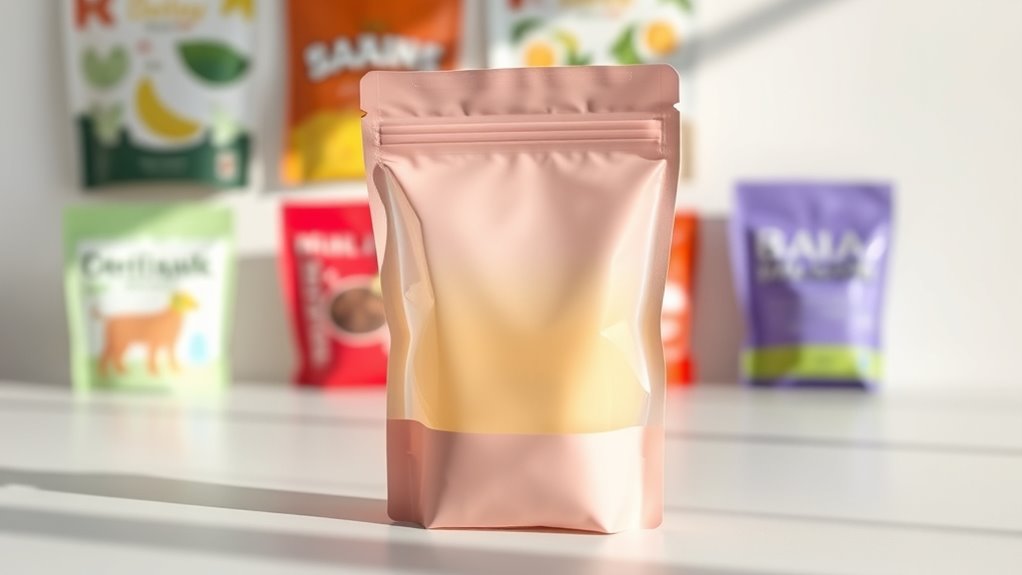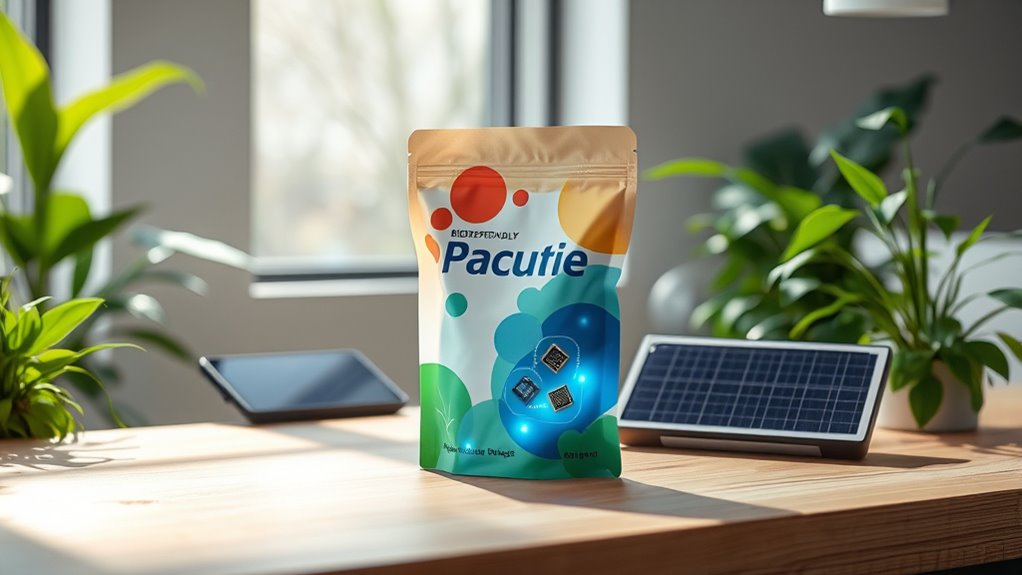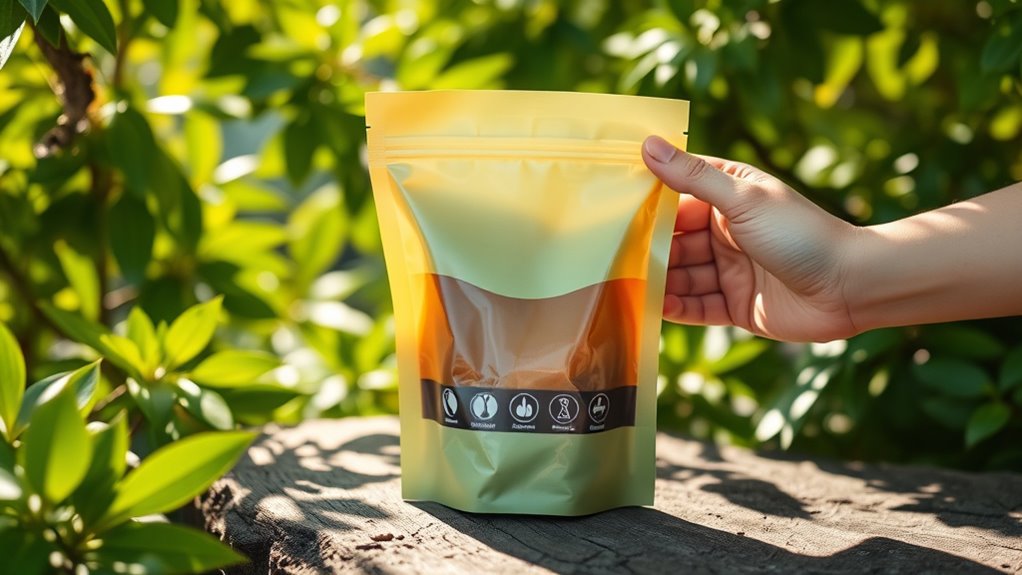By 2025, eco-friendly pouch packaging is evolving with innovative biodegradable materials, plant-based films, and compostable coatings that cut plastic waste. Reusable and refillable designs are becoming more popular, supported by modular and customizable options to reduce material use. Advanced packaging technologies like smart sensors and circular economy principles help improve waste management and promote sustainability. To stay ahead, explore how these trends can redefine eco-conscious packaging and what new innovations are on the horizon.
Key Takeaways
- Adoption of biodegradable, compostable, and plant-based materials to reduce plastic waste and enhance sustainability in pouch packaging.
- Development of refillable, reusable, and modular pouch designs to promote circular economy practices.
- Integration of smart packaging technologies and AI-driven waste management systems for improved recycling and waste reduction.
- Use of minimalist graphics, natural color palettes, and eco symbols to communicate environmental commitment effectively.
- Innovations in eco-friendly coatings and recyclable multilayer films to optimize material efficiency and environmental impact.
Innovative Biodegradable Materials Transforming Pouch Sustainability

Innovative biodegradable materials are revolutionizing pouch sustainability by offering eco-friendly alternatives to traditional plastics. You’ll find that biodegradable coatings are now used to create more eco-conscious packaging, allowing pouches to break down naturally without harming the environment. These coatings form a protective layer that retains functionality while maintaining compostability. Additionally, compostable additives are integrated into pouch materials to enhance biodegradability and performance, ensuring the entire package can decompose efficiently. These advancements reduce plastic waste and lower carbon footprints, aligning with global sustainability goals. By adopting these materials, you contribute to a greener future, supporting waste reduction efforts and fostering more sustainable consumer habits. As these innovations evolve, they open new possibilities for environmentally responsible pouch production. Incorporating natural materials like plant-based polymers further enhances the ecological benefits and aligns with the trend toward biodegradable coatings.
Advances in Refillable and Reusable Pouch Designs

You’ll notice new refill mechanisms making pouches easier to use and reduce waste. Innovations in durable materials also guarantee these pouches last longer and withstand multiple uses. These advances are shaping a more sustainable future for pouch packaging. Additionally, incorporating raw food principles into packaging designs can help preserve product freshness and nutritional value during storage and transportation. Implementing material recyclability can further enhance environmental benefits and support circular economy initiatives. Incorporating recyclable materials that are compatible with existing waste management systems can streamline recycling efforts and reduce contamination. Implementing fraud prevention tools in the manufacturing process can further protect against counterfeit or tampered packaging. Incorporating psychological research on consumer behavior can also guide the development of more effective and appealing eco-friendly designs.
Innovative Refill Mechanisms
As consumers increasingly seek sustainable solutions, refill mechanisms in pouch packaging are evolving to meet these demands. Innovative refill systems make it easier to reuse pouches, reducing waste and supporting sustainable supply chains. Features like snap-on caps, valve systems, and tear-off sections allow for quick, mess-free refilling, encouraging repeat use. These mechanisms also help brands enhance their eco-conscious branding by demonstrating commitment to environmental responsibility. By adopting smarter refill designs, you can minimize packaging waste and lower your carbon footprint, appealing to environmentally aware consumers. The focus on user-friendly, efficient refill systems not only boosts brand loyalty but also aligns with the growing demand for sustainable packaging solutions. Additionally, integrating durable, eco-friendly materials into pouch design can further enhance reusability and environmental benefits. These advances make eco-friendly pouches more practical and attractive for both companies and consumers.
Durable Material Innovations
Advances in durable materials are transforming refillable and reusable pouch designs, making them more resilient and long-lasting. You now have options like biodegradable coatings that protect the pouch while reducing environmental impact. Recycled fiber blends strengthen the material, ensuring durability without sacrificing sustainability. To maximize these innovations, consider:
- Incorporating biodegradable coatings for eco-friendly protection
- Using recycled fiber blends to enhance strength and sustainability
- Designing pouches with reinforced seams for added resilience
- Selecting innovative materials that balance durability with ease of reuse
- Considering material innovation benefits to optimize design choices for better customer engagement and environmental impact. Additionally, understanding the material properties can help in selecting the most suitable materials for different product requirements.
Embracing material testing methods ensures that these advanced materials meet quality standards and performance expectations. These innovations allow you to create pouches that withstand multiple uses, reduce waste, and support eco-conscious goals. Additionally, leveraging sustainable packaging practices can further improve the performance and environmental footprint of your packaging solutions. By leveraging these durable material advancements, you contribute to a more sustainable packaging future.
Use of Plant-Based and Compostable Films in Packaging

The shift toward plant-based and compostable films is transforming packaging by offering sustainable alternatives that reduce environmental impact. These innovations enable you to choose materials like plant-based films that are biodegradable and sourced from renewable resources. Compostable pouches, made from these films, break down naturally in composting environments, minimizing landfill waste. By adopting these materials, you can enhance your brand’s eco-conscious appeal and meet growing consumer demand for sustainability. Plant-based films not only reduce reliance on fossil fuels but also lower carbon footprints during production. As you explore packaging options, integrating compostable pouches made from plant-based films allows you to deliver eco-friendly solutions without compromising product integrity. This shift supports your commitment to environmental responsibility and aligns with future packaging trends. Incorporating sustainable materials into your packaging strategies further emphasizes your dedication to eco-conscious practices and appeals to environmentally aware consumers. Additionally, ongoing advancements in biodegradable technologies continue to improve the performance and cost-effectiveness of these eco-friendly packaging options.
Incorporation of Minimalist and Eco-Conscious Graphics

Incorporating minimalist and eco-conscious graphics into pouch packaging can considerably enhance your brand’s sustainability message. Minimalist design reduces visual clutter, emphasizing simplicity and eco-friendliness. Eco-conscious graphics use natural colors, recycled textures, and straightforward symbols to communicate your commitment. To maximize impact, consider these ideas:
- Use clean, simple lines that reflect sustainability.
- Incorporate natural color palettes like greens, browns, and beiges.
- Display eco symbols such as leaves or recycling icons clearly.
- Limit text to essential information for a sleek, uncluttered look.
- Ensure packaging materials are compatible with Ring Security Cameras to prevent issues like frost buildup or interference.
- Highlight the use of keto-friendly ingredients or other eco-conscious materials to reinforce your sustainability message.
- Pay attention to sound recording techniques to ensure your packaging design aligns with eco-friendly production processes.
- Regularly review your design process to incorporate drone technology for sustainable manufacturing practices.
- Incorporate hybrid bike principles by optimizing design features for versatility and efficiency in your packaging solutions.
Integration of Smart Packaging Technologies for Better Waste Management

As smart packaging technologies become more prevalent, they offer practical solutions for enhancing waste management. Smart sensors embedded in pouches can detect waste levels or contamination, helping optimize disposal processes. Dynamic displays on packaging can communicate recycling instructions or real-time status updates, encouraging responsible disposal. Imagine this setup:
| Smart Sensors | Dynamic Displays | Waste Management Benefits |
|---|---|---|
| Detects fill levels | Shows recycling tips | Reduces contamination |
| Identifies spoilage | Provides disposal prompts | Minimizes landfill waste |
| Monitors integrity | Displays expiry info | Promotes proper sorting |
This integration simplifies waste sorting, minimizes errors, and boosts recycling rates. Additionally, AI-driven analytics can optimize collection routes and waste processing schedules, making waste management more efficient and environmentally friendly. The incorporation of sustainable materials further enhances the eco-friendliness of packaging. Implementing these innovations can also improve consumer engagement, encouraging more responsible disposal habits. Advances in waste tracking technology are enabling more precise monitoring and management of waste streams, leading to better resource utilization. These innovative technologies are transforming waste management into a more efficient and environmentally friendly process, fostering a greener future. You’ll find these technologies making waste management more efficient, environmentally friendly, and user-friendly. Smart sensors and dynamic displays are transforming how packaging contributes to a greener future.
Customization and Modular Pouch Solutions for Reduced Material Use

By adopting customizable and modular pouch designs, manufacturers can considerably cut down on material use without sacrificing functionality. This approach enhances material reduction and boosts design flexibility, making packaging more sustainable. To achieve this, consider:
- Slimmer profiles that use less material while maintaining strength
- Modular sections that allow for tailored sizing, reducing excess space
- Reusable components that adapt to different product sizes
- Multi-purpose designs that serve various applications, minimizing the need for multiple pouch types
These strategies enable you to optimize material efficiency, lower waste, and meet eco-friendly goals. Modular solutions also give you the flexibility to customize packaging for different products, reducing overproduction and aligning with sustainable packaging trends.
Adoption of Circular Economy Principles in Pouch Production

You can improve sustainability by embracing recyclable material innovations and designing pouches for easier recovery. Implementing closed-loop manufacturing systems helps reduce waste and conserves resources. Together, these strategies enable you to align pouch production with circular economy principles effectively.
Recyclable Material Innovations
Innovations in recyclable materials are transforming pouch packaging by embedding circular economy principles into production processes. You can now select materials that are more sustainable and easier to recycle. For example:
- Biodegradable plastics reduce waste and break down naturally, minimizing environmental impact.
- Recyclable multi-layer films improve the reuse potential of pouches.
- Incorporating eco-friendly inks ensures inks don’t hinder recycling or contaminate the recycling stream.
- Advanced sorting technologies enable better identification and separation of recyclable materials.
Closed-Loop Manufacturing Systems
Adopting closed-loop manufacturing systems is central to integrating circular economy principles into pouch production. By implementing advanced recycling technologies, you can reclaim and reprocess materials, minimizing waste and reducing environmental impact. This approach guarantees that materials are reused repeatedly, creating a sustainable cycle within your supply chain. Closed-loop systems help you optimize resource efficiency, lower production costs, and meet eco-friendly standards. Embracing these systems also enhances supply chain sustainability by reducing reliance on virgin materials and decreasing emissions associated with raw material extraction. You become part of a circular economy, where waste is eliminated, and materials are continually reused. This shift not only benefits the environment but also boosts your brand’s reputation among eco-conscious consumers seeking sustainable packaging options.
Consumer Engagement and Transparency in Eco-Friendly Packaging Initiatives

As consumers become increasingly eco-conscious, brands are recognizing the importance of transparency and active engagement in their packaging initiatives. You can build trust by clearly communicating your commitment to sustainable sourcing and eco-friendly practices. To foster consumer involvement, consider these strategies:
- Share stories about your sustainable sourcing processes.
- Use packaging labels to highlight eco-friendly features.
- Offer educational content on your website about eco benefits.
- Encourage feedback and participation in sustainability programs.
Frequently Asked Questions
How Do Biodegradable Pouch Materials Affect Product Shelf Life?
Biodegradable pouch materials can impact your product’s shelf life by offering comparable durability while being environmentally friendly. Their biodegradable durability guarantees the pouch maintains strength and barrier properties, protecting your product from spoilage. However, factors like exposure to moisture or heat may accelerate degradation, potentially shortening shelf life. By choosing high-quality biodegradable materials, you can balance eco-consciousness with product preservation, ensuring your items stay fresh and safe for consumers.
Are Refillable Pouches Cost-Effective for Small Brands?
Refillable pouches can be cost-effective for small brands when you consider supply chain implications and consumer acceptance. They often reduce packaging costs and waste, which appeals to eco-conscious consumers. However, you need to evaluate the initial investment and potential logistics challenges. If your customers embrace the idea of refilling and sustainability, these pouches can boost brand loyalty and save money over time.
What Are the Challenges of Implementing Smart Packaging Technologies?
Imagine trying to fit a puzzle piece into a moving jigsaw—smart packaging faces similar hurdles. You may encounter supply chain complexities that slow implementation, like tangled threads. Consumer acceptance can be a tricky wave to surf, as not everyone’s ready to embrace new tech. The challenge lies in balancing innovation with simplicity, ensuring your smart packaging is both functional and appealing—without getting lost in the maze of technical and market uncertainties.
How Do Minimalist Graphics Influence Consumer Perception of Eco-Friendly Packaging?
Minimalist graphics improve how consumers perceive eco-friendly packaging by creating a clear visual hierarchy, making key sustainability messages stand out. You notice that simple designs often appear more authentic and trustworthy, enhancing brand recognition. By reducing clutter, you focus on essential information, reinforcing your eco-conscious choice. This streamlined approach positively influences your perception, making you more likely to support brands that prioritize sustainability with minimalist visuals.
Can Modular Pouch Designs Be Easily Customized for Different Products?
You’ll find that modular pouch designs offer great flexibility for customization. With modular flexibility and design adaptability, you can easily tailor pouches to different products, sizes, and branding needs. This approach allows you to swap components or adjust layouts without starting from scratch, making it simple to meet diverse packaging requirements. Overall, modular pouches streamline your process, saving time while giving you the versatility to innovate and personalize your packaging solutions.
Conclusion
Imagine your pouch as a leaf floating gently downstream, seamlessly blending into nature’s cycle. By embracing biodegradable materials, smart tech, and circular principles, you’re not just packaging; you’re nurturing a sustainable ecosystem. As brands innovate with refillable designs and eco-conscious graphics, you become part of a movement that’s turning waste into opportunity. Together, you’re steering toward a future where packaging is as gentle on the planet as a whisper of wind through trees.
Susannah expertise lies in researching and compiling evidence-based content on juicing, nutrition, and overall health. She is committed to ensuring that The Juicery World offers accurate, up-to-date, and trustworthy information to empower readers to take control of their health. Susannah’s goal is to inspire individuals to embrace juicing as a way to nourish their bodies and live their best lives.











